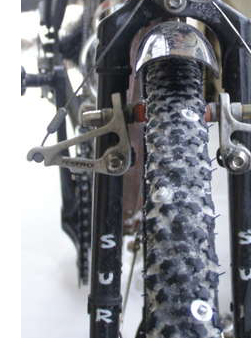If you are a cyclist for whom the end of British Summer Time at 2.00am on Sunday 30th October signals a new season of cycling, rather than two-wheeled hibernation, how do you equip yourself for the winter months ahead without being fleeced?
Cycling in winter brings its owns challenges, but according to the marketing blurb put out at this time of year you might be fooled into believing we live within the arctic circle and need to spend hundreds of pounds in order to survive the next few months on two wheels.
Cheap winter cycling
By following a few simple tips it is possible for cycling in the colder months to be as rewarding as at any other time of the year. And as inexpensive.
| Winter cycling | Top 10 money-saving tips |
|---|---|
| Does your bike need a winter service? | If you have well-adjusted brakes and a good amount of tread on your tyres a can of moisture-repelling oil such as WD40 will keep most parts of your bike well protected from the weather. Cost: From £1.95 |
| Clothing | Specialist cycling gear can be eye-wateringly expensive. Shops like Aldi, Lidl or Tchibo often have similar items of clothing at bargain prices. Cost: cycle rear pannier set £15, cycling shoes £16. |
| Mudguards | Whatever the type of bike you ride, a traditional full-length mudguard need not be any heavier and will better protect your feet and lower legs from road spray. Cost: Couriers adapt a 1.5litre plastic drinks bottle into a rear mudguard for pennies, but most of us pay the shop price of £20-£30 for a set |
| Shoes | Cycling with wet feet in the cold is a miserable experience and there are all manner of neoprene overshoes and booties on the market that claim to keep your shoes and feet dry. The cheapest option is to place a plastic sandwich bag over your sock before putting on your shoes. Cost: 1p Goretex hiking shoes with socks designed to wick away moisture can be a solution for the cyclists who forgo clipless pedals in the slippery conditions where they might need to put a foot down quicker than usual to avoid a fall.  |
| Lights | It’s common to see urban cyclists sporting numerous lights, but since the flashing-only mode became legal one good set of LED lights should be sufficient to get you seen. There are lights to suit every pocket – Tesco do a perfectly adequate front and rear set in their value range for less than £10. |
Tyres |
Conventional mountain bike tyres are more than up to dealing with a few inches of snow, but ice provides far more of a challenge. With severe cold weather predicted this winter, cyclists who like to stay on two wheels whatever the conditions but would rather not invest in a snow bike or pay around £50 for a single tyre fitted with metal spikes can adapt their existing tyres for less than £2. You will need only a rivet gun a handful of pop rivets and a few moments to study the photos at the excellent instructables.com Cost: £1.50 |
| Scrapes and prangs | Cycle insurance should cover more than just theft. A good policy will pay for your bike to be repaired should you come off on slippery roads. Cost: From 34p a week |
| Ride safe | If the weather turns really nasty, follow our “tips for riding in snow, ice and slush”:/2010/01/13/tips-cycling-snow-ice-and-slush Cost: Nothing |
| Know your rights | Should the worst happen and you are knocked off your bike, contact a “reputable cycle accident helpline”:/insurance/cycle/legal-helpline to get the compensation you deserve. Cost: Nothing |
Cycle insurance with built-in legal protection
Cycle insurance from the ETA includes new-for-old replacement and accidental damage, £1m third party insurance, personal accident cover, worldwide cover and if you should be knocked off your bike our specialist legal team fight your corner. From 34p per week.


0 Comments View now